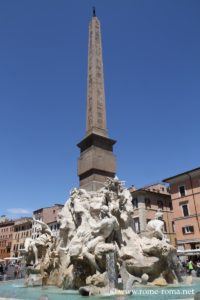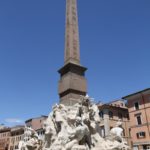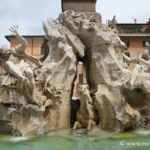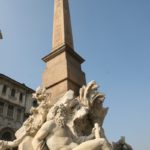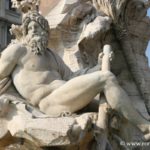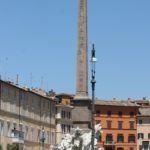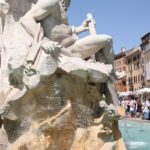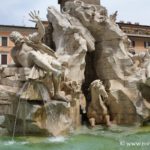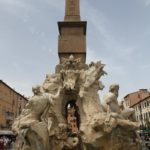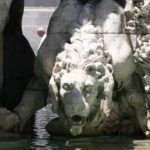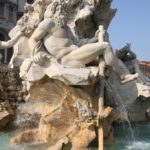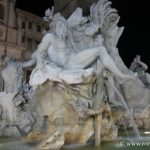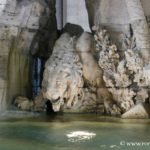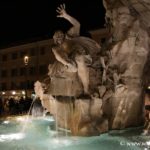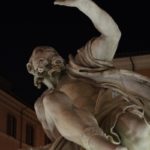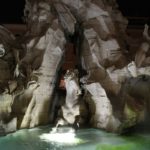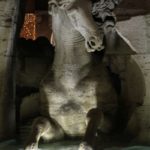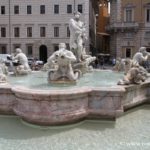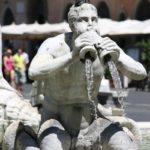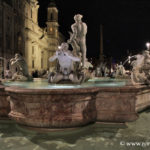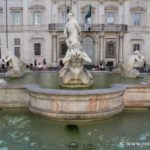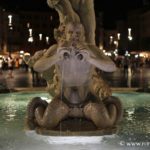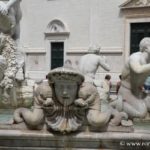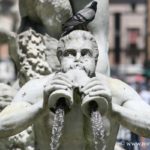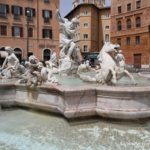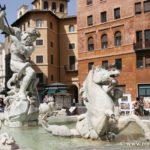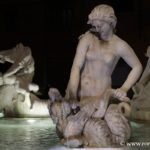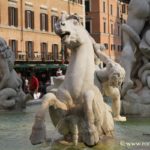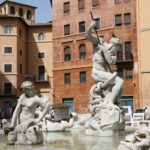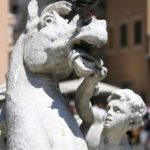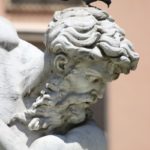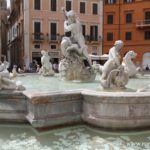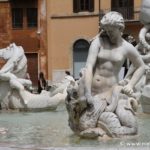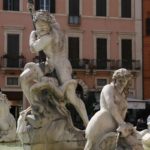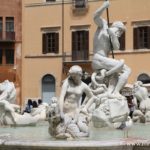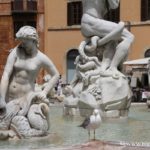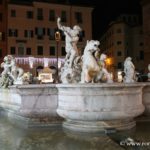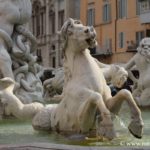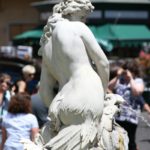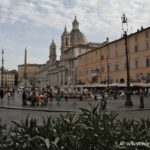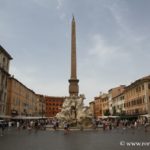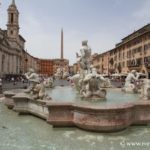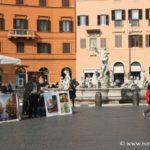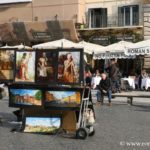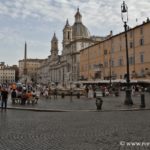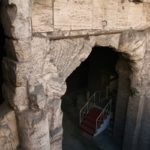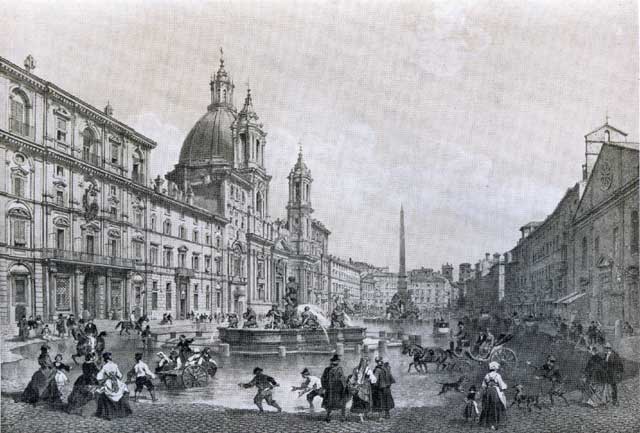Three very beautiful fountains are located in Piazza Navona, including the Baroque masterpiece of the Fountain of the Four Rivers at the center created by Bernini in the 17th century, on which stands the large obelisk.
This page is dedicated to all the monuments on the square, also including the Moor Fountain, the Neptune Fountain, the Pamphilj Palace and the churches of Saint Agnes in Agone and Our Lady of the Sacred Heart.
→ See also the article on Piazza Navona for a general overview and its history.
Fountain of the Four Rivers
At the center of the square, the Fountain of the Four Rivers, created by Bernini, was inaugurated in 1651. It supports an Egyptian obelisk, surrounded by the statues personifying the Ganges, the Rio de la Plata, the Nile, and the Danube. It is one of the most beautiful Baroque monuments in Rome.
Its construction was initiated under Innocent X in 1647 to replace a simple rectangular basin that served as a horse trough. To this end, a dedicated conduit was built from the Acqua Vergine aqueduct to supply water.
The initial project was to be entrusted to Borromini, but it was his rival Gian Lorenzo Bernini, known as Bernini, who was ultimately chosen, even though he was in disgrace with the pope. Bernini had approached Donna Olimpia, the powerful “mistress of Rome,” the pope’s sister-in-law and a “close” advisor, gifting her a silver model of his fountain project. The pope supposedly “accidentally” came across the model and was delighted by it.
The construction cost was so high that the pope raised taxes on bread and wine. Romans, who already disliked Donna Olimpia, hated her even more, blaming her.
The addition of the obelisk was a papal requirement, after he saw it lying among the remains of Domitian’s stadium along the old Appian Way during a visit to Saint Sebastian in April 1647.
The name of Domitian inscribed in hieroglyphs on the monolith indicates that it formerly stood in the “Temple of Isis” located on the Field of Mars.
This Agonale Obelisk, 16.54 meters tall, was erected on a base on August 12, 1649. The monolith symbolizes divine power descending like a solar ray and radiating in four directions through the four rocks which might evoke chaos.
The four white marble statues are five meters tall, installed on the four protruding travertine rocks surrounding the obelisk.
The Nile is the work of Giacomo Antonio Fancelli, remarkable for the veiled head, reminding that the source of the river was still unknown. However, the people liked to interpret it as Bernini’s disdain for his rival Borromini, the architect of the neighboring church of Saint Agnes in Agone. By the same rumor, the raised arm with the hand in a protective gesture of the Rio de la Plata was meant to mock Borromini by expressing fear that the church might collapse. However, the fountain was completed long before the church was even started, which discredits this popular version.
That statue of the Rio della Plata is by Francesco Baratta, the Ganges is by Claude Poussin, and the Danube is by Antonio Raggi.
On the rock is the coat of arms of the Pamphilj family—a dove carrying an olive branch.
- Fountain of the Four Rivers
- Fontana dei Quattro Fiumi
- Fontana dei Quattro Fiumi
- The Ganges, Fountain of the Four Rivers
Moor Fountain
The Moor Fountain (Fontana del Moro in Italian), located on the southeast side facing the Pamphilj palace, was made in 1574 under the pontificate of Gregory XIII Boncompagni by Giacomo della Porta. Fitted with a polylobed basin, it originally rested on a travertine base with two stair steps, surrounded by a balustrade with twelve small columns to protect it from market carts. The stone basin was decorated with sea monsters, bearing the Boncompagni family crest with a dragon and an eagle. In the center water spouted from a group of rocks.
In 1652, Innocent X asked Bernini to restore it. He only replaced the central rock with a small group of three dolphins supporting a large snail that spouted water. This assembly pleased neither the Pamphilj nor the Romans, and was replaced in 1655 by the statue of the Moor, also called the Ethiopia wrestling a dolphin, designed by Bernini and sculpted by Giovan Antonio Mari, representing a half‑man half‑marine creature (a triton) holding a dolphin attempting to escape. Water spouts from the dolphin’s mouth. Later the steps and balustrade were removed to allow the pretty low‑level pool.
- Fountain of the Moor
- Fountain of the Moor
- Fontana del Moro
- Fontana del Moro
- Fontana del Moro
Neptune Fountain
On the north side, the Neptune Fountain was also created by Giacomo della Porta in 1574. It was previously called the Cauldron‑makers’ Fountain (Fontana dei Calderari in Italian), because it was located near copper‑ware artisans. It remained undecorated until 1873, when the Municipality of Rome organized a competition and entrusted the ornamentation project to the Sicilian Zappalà and the Roman Della Bitta. Zappalà created the sea horses ridden by children, mermaids struggling with sea monsters, and winged cherubs playing with dolphins. Della Bitta made the central statue representing Neptune with the trident fighting an octopus coiled around his legs.
- Fountain of Neptune, Piazza Navona
- Fountain of Neptune
- Fontana di Nettuno
- Fontana di Nettuno
General views of the square
- Overview
- The square with the obelisk
- Piazza Navona, Fontana del Moro in the foreground
Remains of Domitian’s Stadium
See the dedicated page on the Stadium of Domitian.
- Remains of the Domitian stadium
Pamphilj Palace
It was Girolamo Rainaldi who built the imposing Pamphilj Palace, renovating the former Pamphili, Cybo and Mellini palaces owned by the family. It was Cardinal Giovanni Battista Pamphilj, who became Pope Innocent X in 1644, who decided on this renovation around 1630.
At the time, the Pamphilj competed in prestige with other powerful Roman families such as the Farnese and Barberini. Under Innocent X’s pontificate the palace underwent significant embellishment.
The building consists of a central block featuring pilasters and arcades on the façade. On the piano nobile the central balcony is supported by columns above a vaulted portal. Between the windows of the second floor emerges the Pamphilj coat of arms, with three lilies above a dove holding an olive branch in its beak.
Above the cornice is a loggia with three arches and two windows.
The lateral wings consist of two similar buildings.
Born in Viterbo, she moved into the palace after marrying Pamphilio Pamphilj. Very unpopular, she amassed such wealth after becoming a widow — during the pontificate of her brother-in-law Innocent X, of whom she was the advisor — that she was suspected of being his lover.
Her son, Cardinal Camillo Pamphily, therefore nephew of the Pope, married Olimpia Aldobrandini, who brought the Aldobrandini Palace as a dowry, now called the Doria-Pamphilj Palace. The family later moved there and rented out the palace on Piazza Navona.
The building has three courtyards, and inside, decorations from the former Pamphilj palace have been preserved, including works by Agostino Tassi. The piano nobile has 23 rooms decorated with frescoes by artists such as Giacinto Gemignani, Gaspard Dughet, Andrea Camassei, Giacinto Brandi, Francesco Allegrini, Pier Francesco Mola, and Costanzo de Peris. The most remarkable are probably the frescoes by Pietro da Cortona, who painted the long gallery between 1651 and 1654, designed by Borromini, with scenes from the Stories of Aeneas.
One wing of the palace has housed the Brazilian Embassy in Italy since 1920. The complex is connected to the Church of Saint Agnes in Agone, considered the family’s private chapel, and the Collegio Innocenzio.
Churches
 Church of Our Lady of the Sacred Heart
Church of Our Lady of the Sacred Heart
Panini 1729, Preparation of the fireworks display in Piazza Navona, Rome, on November 30, 1729, on the occasion of the birth of the Dauphin.
- Piazza Navona: a masterpiece of Baroque art
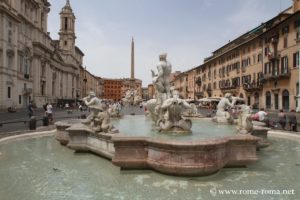 The magnificent Navona Square, Piazza Navona in Italian, is among the most iconic squares of Rome. One of the liveliest and most frequented places in ...
The magnificent Navona Square, Piazza Navona in Italian, is among the most iconic squares of Rome. One of the liveliest and most frequented places in ...

